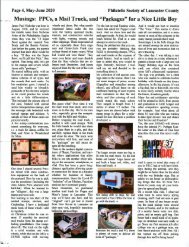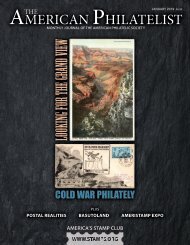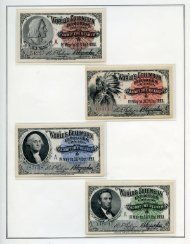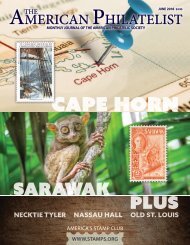August 2018 - Sneak Peek
The American Philatelist is the monthly journal of the American Philatelic Society, the world's largest organization for stamp collectors and enthusiasts. Members receive the printed magazine and can access the digital edition as a benefit of membership in the Society. Please enjoy this sneak peek. We're confident that once you see all that we offer, you'll want to join the APS today.
The American Philatelist is the monthly journal of the American Philatelic Society, the world's largest organization for stamp collectors and enthusiasts. Members receive the printed magazine and can access the digital edition as a benefit of membership in the Society. Please enjoy this sneak peek. We're confident that once you see all that we offer, you'll want to join the APS today.
You also want an ePaper? Increase the reach of your titles
YUMPU automatically turns print PDFs into web optimized ePapers that Google loves.
story:<br />
It appears that a Cheyenne decided<br />
to sleep at the base of the monolith<br />
next to the head of a buffalo. In<br />
the morning he found that the Great<br />
Spirit had transported both him and<br />
the buffalo head to the top of the<br />
rock. As there was no easy way down<br />
he had no option but to spend another<br />
day and night on the rock without<br />
food and water. After a day of prayer<br />
asking for deliverance, he awoke the<br />
following day to find that the Great<br />
Spirit had brought him back down to<br />
the ground, but left the buffalo head<br />
at the top of the tower near its edge.<br />
Wooden Leg maintains that the buffalo<br />
head was clearly visible through<br />
a spyglass, which the old man happened<br />
to have in his possession. In<br />
their camps, the Northern Cheyenne<br />
would always have a sacred teepee<br />
in honor of the Great Spirit, and the<br />
sacred object in this teepee was the<br />
head of a buffalo.<br />
European American fur trappers<br />
probably visited Devils Tower, but<br />
they left no written evidence. The<br />
first documented European American<br />
visitors were a military detachment under the command<br />
of Lieutenant Henry Maynadier. They were part of the 1859<br />
expedition to the Upper Yellowstone region led by Captain<br />
William Franklin Reynolds (1820-1894) of the United States<br />
Army Corps of Topographical Engineers. Sixteen years later<br />
in 1875, Colonel Richard Irving Dodge (1827-1895) escorted<br />
an Office of Indian Affairs scientific survey party to<br />
the massive rock formation. As was often the case with such<br />
expeditions, Dodge’s interpreter was somewhat less than linguistically<br />
competent and clumsily rendered the name of the<br />
monolith as “Bad God’s Tower.” There was no going back, and<br />
it was soon called “Devil’s Tower.” In 1890, the apostrophe<br />
was dropped, and it became Devils Tower.<br />
In February 1890, local artist Charles “Chas” Graham<br />
tried to prevent the tower and the surrounding area from<br />
falling into the hands of private entrepreneurs. To that end<br />
he filed a pre-emption application for the lands on which<br />
the tower is situated. In <strong>August</strong> of the same year, the General<br />
Land Office issued an order to reject all applications on<br />
these lands, thus forestalling attempts to acquire the tower for<br />
speculative and other purposes.<br />
Meanwhile, support grew for the idea of preserving the<br />
tower as a national or state park. In February 1892, Senator<br />
Francis E. Warren (1844-1929) of Wyoming wrote to the<br />
commissioner of the General Land Office asking him for assistance<br />
in preventing the spoliation of Devils Tower and the<br />
Devils Tower Bear Legend, showing Mato, the bear,<br />
by Herbert Alexander Collins, hangs at the Devils<br />
Tower Visitor Center. Collins was born in Canada<br />
but emigrated to Nebraska in 1884, spending the<br />
rest of his life in the U.S. The painting is also known<br />
unofficially as “How the Bear Lost His Claws.”<br />
(Image courtesy of Devils Tower Visitor Center.)<br />
Little Missouri Buttes, located several<br />
miles to the northeast. Several<br />
weeks later, the land office issued an<br />
order under the Forest Reserve Act<br />
of March 31, 1891, setting aside some<br />
60.5 square miles, which included<br />
both the tower and the Little Missouri<br />
Buttes as a temporary forest reserve.<br />
This reserve was reduced in size<br />
in June 1892, and the unreserved<br />
portion was restored to settlement in<br />
1898. In the same year, Senator Warren<br />
introduced a bill (S. 3364) for<br />
the establishment of Devils Tower<br />
National Park. Acting on the advice<br />
of the General Land Office, the senator<br />
requested in his proposal that<br />
18.75 square miles or 11,974.24 acres,<br />
which include both Devils Tower and<br />
the Little Missouri Buttes, be set aside<br />
for the park. The bill, which was introduced<br />
on July 1, 1892, was read<br />
twice by its title and referred to the<br />
Committee on Territories, where it<br />
remained.<br />
The necessary impetus for legislation<br />
was a result of a tour of the<br />
Southwest undertaken by Iowa Congressman<br />
John Fletcher Lacey (1841-<br />
1913), who chaired the House Committee on Public Lands,<br />
and archaeologist Edgar Lee Hewett (1865-1946) to investigate<br />
the depredations of “pot hunters” on prehistoric Native<br />
American ruins. This led to a bill that gave the president the<br />
right to establish national monuments by means of a proclamation.<br />
The bill became the Antiquities Act of 1906 (Public Law<br />
59-209), also known as the Lacey Act, which authorized the<br />
president to proclaim historical landmarks, historic and prehistoric<br />
structures and other objects of historic and/or scientific<br />
interest on land owned or controlled by the government,<br />
to be preserved for the enjoyment of all. This legislation was<br />
prompted by the concern that many of these sites were being<br />
damaged by tourists and, more importantly, in danger of being<br />
destroyed by the incursion of enterprises such as those<br />
undertaking strip mining.<br />
President Roosevelt signed the Act on June 8, 1906, and<br />
moved quickly. Within the space of three years a number of<br />
national monuments were established. Of these, nine became<br />
national parks or were given another status, and others were<br />
transferred to state control or eventually disbanded. In addition<br />
to the Devils Tower National Monument, Roosevelt<br />
gave the national monument status in 1906 to El Morro<br />
(New Mexico), Montezuma Castle (Arizona); in 1907 to Gila<br />
Cliff Dwellings (New Mexico), Tonto (Arizona); in 1908 to<br />
Jewel Cave (South Dakota), Muir Wood (California), Natu-<br />
772 AMERICAN PHILATELIST / AUGUST <strong>2018</strong>

















